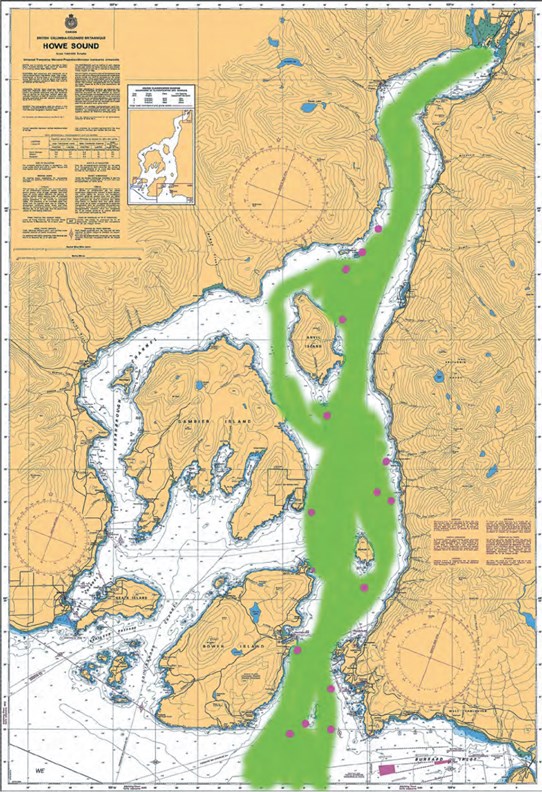A new report on Howe Sound from the Vancouver Aquarium’s Coastal Ocean Research Institute (CORI) says the sound shows signs of a remarkable recovery since the last century, but remains vulnerable to development, shipping, and fishing pressures.
The report, which runs to well over 350 pages, looks at the state of Howe Sound in seven broad categories: species and habitats, clean water, sense of place and well being, coastal development and livelihoods, stewardship and governance, oceanography and climate change, and seafood.
Ruth Simons, executive director of the Future of Howe Sound Society (FHSS), was one of the authors of the section on stewardship and governance. The society has been a long-time advocate of comprehensive planning for Howe Sound, and Simons told Coast Reporter she thinks the CORI report could give a real boost to those efforts.
“The working together of everybody and pooling of resources and energies can only help to make sure that the ongoing recovery and appreciation of this region as an important biosphere continues,” Simons said.
West Vancouver-Sunshine Coast-Sea to Sky Country MP Pam Goldsmith-Jones said the report will be a valuable resource for her as she makes the case in Ottawa for measures to protect Howe Sound.
“As far as I’m concerned, it’s a blueprint for how we can move forward as a community, and it’s indicative of all the different interest groups that are working together toward a common cause.”
The CORI report was released just days after federal Fisheries Minister Dominic LeBlanc announced new marine protected areas in Hecate Strait and Queen Charlotte Sound to help preserve glass sponge reefs, raising hopes that more of the reefs in Howe Sound will also get protection. The report says 16 new reefs have been identified. So far, only the reefs around Passage Island and the Defence Islands northeast of Anvil Island are in a protected area.
Goldsmith-Jones said those areas on the north coast were a top priority for the Canadian Parks and Wilderness Society (CPAWS), but Howe Sound remains on the federal government’s radar. “The protection of the sponge reefs in Howe Sound is most important to us [locally] and we’ll keep working with [CPAWS] on that.”
Derelict vessels, another file Goldsmith-Jones has been working on, also get a mention in the report. “During the last decade, there has been an increase in the number of boats abandoned in Howe Sound … Due to a lack of identification such as boat name or hull identification number, tracking down the owner is difficult. As a result, often the cost of removal and disposal of wrecked and abandoned vessels falls upon concerned citizens and local government,” it says.
Other sections of the report include a look at marine life around the HMCS Annapolis artificial reef, and how well the area is recovering from dioxin and furan contamination created by pulp and paper production at Woodfibre and Port Mellon.
According to the report, almost 50 species of marine flora and fauna have been documented at the Annapolis site, including two species of rockfish and 12 species unique to the artificial reef.
Researchers found that the contamination from more than a century of pulp and paper production is still there, but in much lower levels than before. “Recent sampling reveals that dioxins and furans remain in the sediment in the proximity of HSPP, but levels in sediments are in general decreasing.”
Simons said one of the most valuable aspects of the report is the fact it lays out steps citizens and governments can take to improve the health of Howe Sound. “What I do see is incremental improvements,” she said. “We’re moving along with the different parts of the planning puzzle. As an example, as communities are going through revisions of their official community plans they have the bigger context in mind.”
It also highlights the value of so-called citizen science, calling the volunteers and advocates working on various issues “critical eyes on the sound … and ambassadors for Howe Sound’s nature and health.”
Goldsmith-Jones said the report shows how the Vancouver Aquarium researchers, First Nations and local, provincial and federal governments are serious about working together on issues affecting Howe Sound. “I don’t think there’s much question that on the ground people are together,” she said, pointing to the success of the Howe Sound Community Forum. “I participated in it for 20 years. It’s been in the last five or six that it’s really come together, and really has the attention of elected officials. Those meetings now have 70 or 80 people at them. There were just a handful when it started.”
The full CORI report is online at: oceanwatch.ca



